Consumer Decision-Making and B2B/B2C Approaches
VerifiedAdded on 2020/10/05
|15
|4298
|335
AI Summary
This report focuses on the essential element of consumer decision-making in organizations. It highlights the significance of persuading individual decisions and discusses two distinct approaches - Business-to-Business (B2B) and Business-to-Consumer (B2C). The analysis emphasizes the need for separate market research methods for each approach, providing valuable insights for businesses seeking to understand consumer behavior.
Contribute Materials
Your contribution can guide someone’s learning journey. Share your
documents today.

Consumer Behaviour and Insight
Secure Best Marks with AI Grader
Need help grading? Try our AI Grader for instant feedback on your assignments.
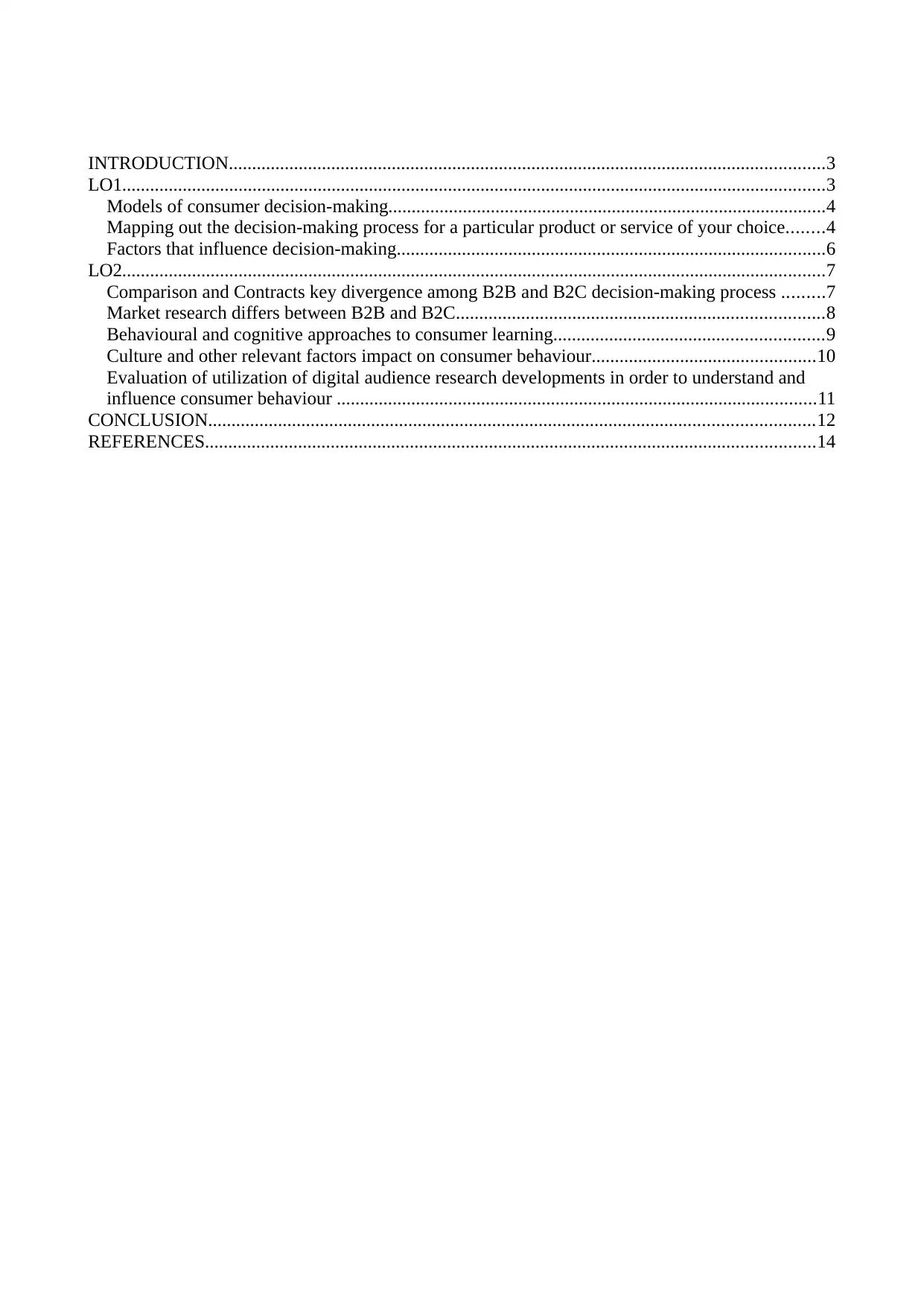
INTRODUCTION................................................................................................................................3
LO1.......................................................................................................................................................3
Models of consumer decision-making..............................................................................................4
Mapping out the decision-making process for a particular product or service of your choice........4
Factors that influence decision-making............................................................................................6
LO2.......................................................................................................................................................7
Comparison and Contracts key divergence among B2B and B2C decision-making process .........7
Market research differs between B2B and B2C...............................................................................8
Behavioural and cognitive approaches to consumer learning..........................................................9
Culture and other relevant factors impact on consumer behaviour................................................10
Evaluation of utilization of digital audience research developments in order to understand and
influence consumer behaviour .......................................................................................................11
CONCLUSION..................................................................................................................................12
REFERENCES...................................................................................................................................14
LO1.......................................................................................................................................................3
Models of consumer decision-making..............................................................................................4
Mapping out the decision-making process for a particular product or service of your choice........4
Factors that influence decision-making............................................................................................6
LO2.......................................................................................................................................................7
Comparison and Contracts key divergence among B2B and B2C decision-making process .........7
Market research differs between B2B and B2C...............................................................................8
Behavioural and cognitive approaches to consumer learning..........................................................9
Culture and other relevant factors impact on consumer behaviour................................................10
Evaluation of utilization of digital audience research developments in order to understand and
influence consumer behaviour .......................................................................................................11
CONCLUSION..................................................................................................................................12
REFERENCES...................................................................................................................................14
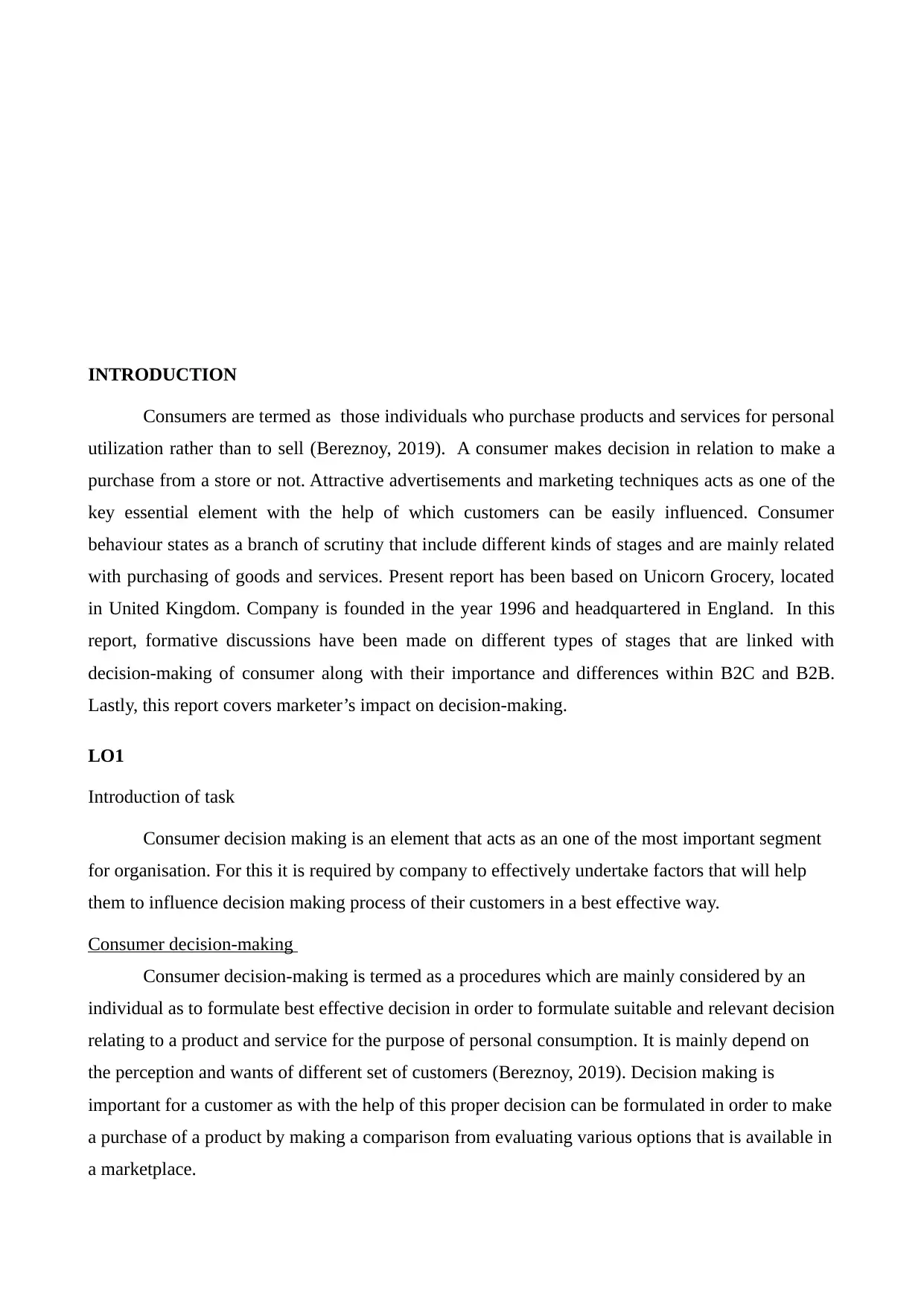
INTRODUCTION
Consumers are termed as those individuals who purchase products and services for personal
utilization rather than to sell (Bereznoy, 2019). A consumer makes decision in relation to make a
purchase from a store or not. Attractive advertisements and marketing techniques acts as one of the
key essential element with the help of which customers can be easily influenced. Consumer
behaviour states as a branch of scrutiny that include different kinds of stages and are mainly related
with purchasing of goods and services. Present report has been based on Unicorn Grocery, located
in United Kingdom. Company is founded in the year 1996 and headquartered in England. In this
report, formative discussions have been made on different types of stages that are linked with
decision-making of consumer along with their importance and differences within B2C and B2B.
Lastly, this report covers marketer’s impact on decision-making.
LO1
Introduction of task
Consumer decision making is an element that acts as an one of the most important segment
for organisation. For this it is required by company to effectively undertake factors that will help
them to influence decision making process of their customers in a best effective way.
Consumer decision-making
Consumer decision-making is termed as a procedures which are mainly considered by an
individual as to formulate best effective decision in order to formulate suitable and relevant decision
relating to a product and service for the purpose of personal consumption. It is mainly depend on
the perception and wants of different set of customers (Bereznoy, 2019). Decision making is
important for a customer as with the help of this proper decision can be formulated in order to make
a purchase of a product by making a comparison from evaluating various options that is available in
a marketplace.
Consumers are termed as those individuals who purchase products and services for personal
utilization rather than to sell (Bereznoy, 2019). A consumer makes decision in relation to make a
purchase from a store or not. Attractive advertisements and marketing techniques acts as one of the
key essential element with the help of which customers can be easily influenced. Consumer
behaviour states as a branch of scrutiny that include different kinds of stages and are mainly related
with purchasing of goods and services. Present report has been based on Unicorn Grocery, located
in United Kingdom. Company is founded in the year 1996 and headquartered in England. In this
report, formative discussions have been made on different types of stages that are linked with
decision-making of consumer along with their importance and differences within B2C and B2B.
Lastly, this report covers marketer’s impact on decision-making.
LO1
Introduction of task
Consumer decision making is an element that acts as an one of the most important segment
for organisation. For this it is required by company to effectively undertake factors that will help
them to influence decision making process of their customers in a best effective way.
Consumer decision-making
Consumer decision-making is termed as a procedures which are mainly considered by an
individual as to formulate best effective decision in order to formulate suitable and relevant decision
relating to a product and service for the purpose of personal consumption. It is mainly depend on
the perception and wants of different set of customers (Bereznoy, 2019). Decision making is
important for a customer as with the help of this proper decision can be formulated in order to make
a purchase of a product by making a comparison from evaluating various options that is available in
a marketplace.
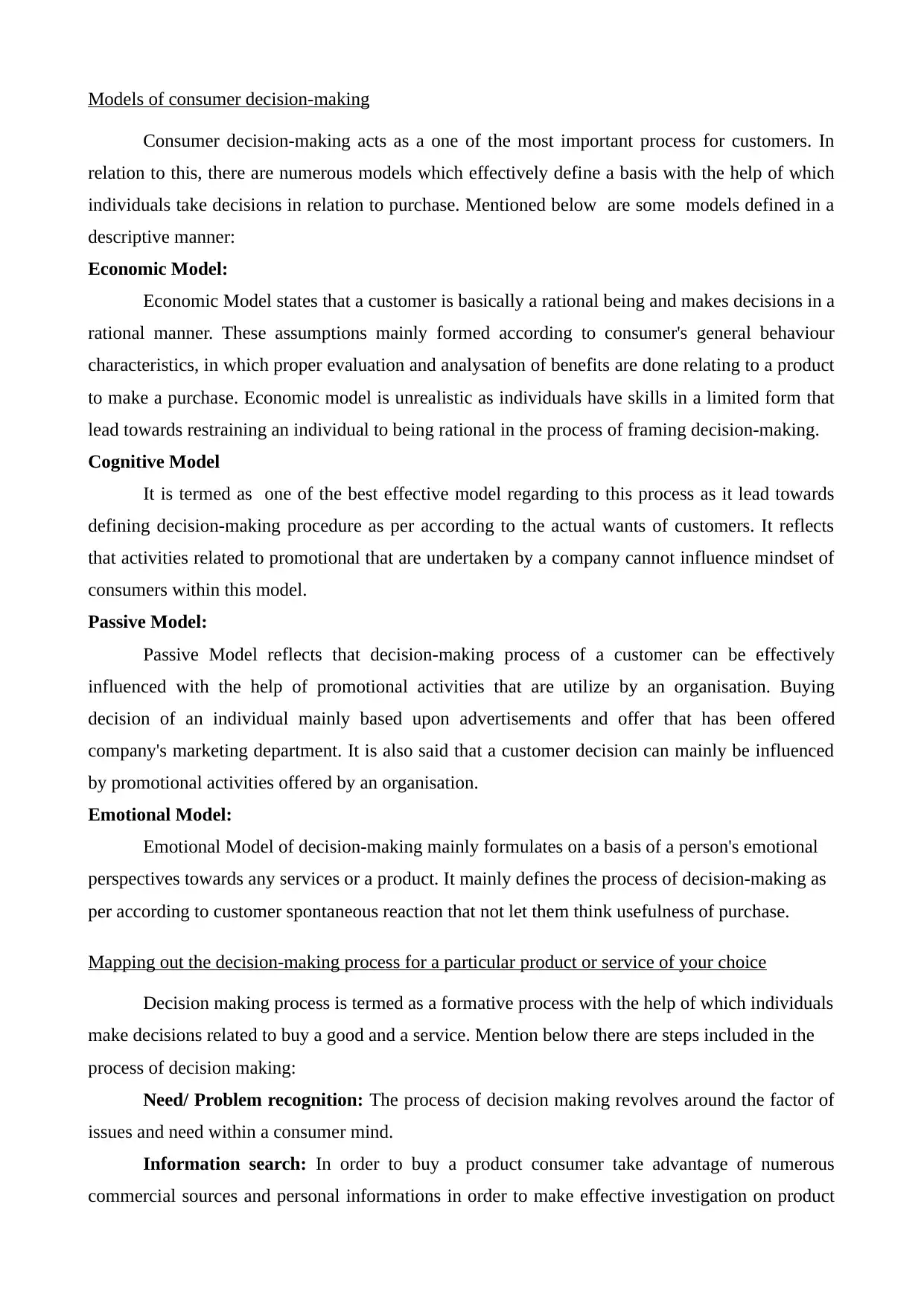
Models of consumer decision-making
Consumer decision-making acts as a one of the most important process for customers. In
relation to this, there are numerous models which effectively define a basis with the help of which
individuals take decisions in relation to purchase. Mentioned below are some models defined in a
descriptive manner:
Economic Model:
Economic Model states that a customer is basically a rational being and makes decisions in a
rational manner. These assumptions mainly formed according to consumer's general behaviour
characteristics, in which proper evaluation and analysation of benefits are done relating to a product
to make a purchase. Economic model is unrealistic as individuals have skills in a limited form that
lead towards restraining an individual to being rational in the process of framing decision-making.
Cognitive Model
It is termed as one of the best effective model regarding to this process as it lead towards
defining decision-making procedure as per according to the actual wants of customers. It reflects
that activities related to promotional that are undertaken by a company cannot influence mindset of
consumers within this model.
Passive Model:
Passive Model reflects that decision-making process of a customer can be effectively
influenced with the help of promotional activities that are utilize by an organisation. Buying
decision of an individual mainly based upon advertisements and offer that has been offered
company's marketing department. It is also said that a customer decision can mainly be influenced
by promotional activities offered by an organisation.
Emotional Model:
Emotional Model of decision-making mainly formulates on a basis of a person's emotional
perspectives towards any services or a product. It mainly defines the process of decision-making as
per according to customer spontaneous reaction that not let them think usefulness of purchase.
Mapping out the decision-making process for a particular product or service of your choice
Decision making process is termed as a formative process with the help of which individuals
make decisions related to buy a good and a service. Mention below there are steps included in the
process of decision making:
Need/ Problem recognition: The process of decision making revolves around the factor of
issues and need within a consumer mind.
Information search: In order to buy a product consumer take advantage of numerous
commercial sources and personal informations in order to make effective investigation on product
Consumer decision-making acts as a one of the most important process for customers. In
relation to this, there are numerous models which effectively define a basis with the help of which
individuals take decisions in relation to purchase. Mentioned below are some models defined in a
descriptive manner:
Economic Model:
Economic Model states that a customer is basically a rational being and makes decisions in a
rational manner. These assumptions mainly formed according to consumer's general behaviour
characteristics, in which proper evaluation and analysation of benefits are done relating to a product
to make a purchase. Economic model is unrealistic as individuals have skills in a limited form that
lead towards restraining an individual to being rational in the process of framing decision-making.
Cognitive Model
It is termed as one of the best effective model regarding to this process as it lead towards
defining decision-making procedure as per according to the actual wants of customers. It reflects
that activities related to promotional that are undertaken by a company cannot influence mindset of
consumers within this model.
Passive Model:
Passive Model reflects that decision-making process of a customer can be effectively
influenced with the help of promotional activities that are utilize by an organisation. Buying
decision of an individual mainly based upon advertisements and offer that has been offered
company's marketing department. It is also said that a customer decision can mainly be influenced
by promotional activities offered by an organisation.
Emotional Model:
Emotional Model of decision-making mainly formulates on a basis of a person's emotional
perspectives towards any services or a product. It mainly defines the process of decision-making as
per according to customer spontaneous reaction that not let them think usefulness of purchase.
Mapping out the decision-making process for a particular product or service of your choice
Decision making process is termed as a formative process with the help of which individuals
make decisions related to buy a good and a service. Mention below there are steps included in the
process of decision making:
Need/ Problem recognition: The process of decision making revolves around the factor of
issues and need within a consumer mind.
Information search: In order to buy a product consumer take advantage of numerous
commercial sources and personal informations in order to make effective investigation on product
Secure Best Marks with AI Grader
Need help grading? Try our AI Grader for instant feedback on your assignments.
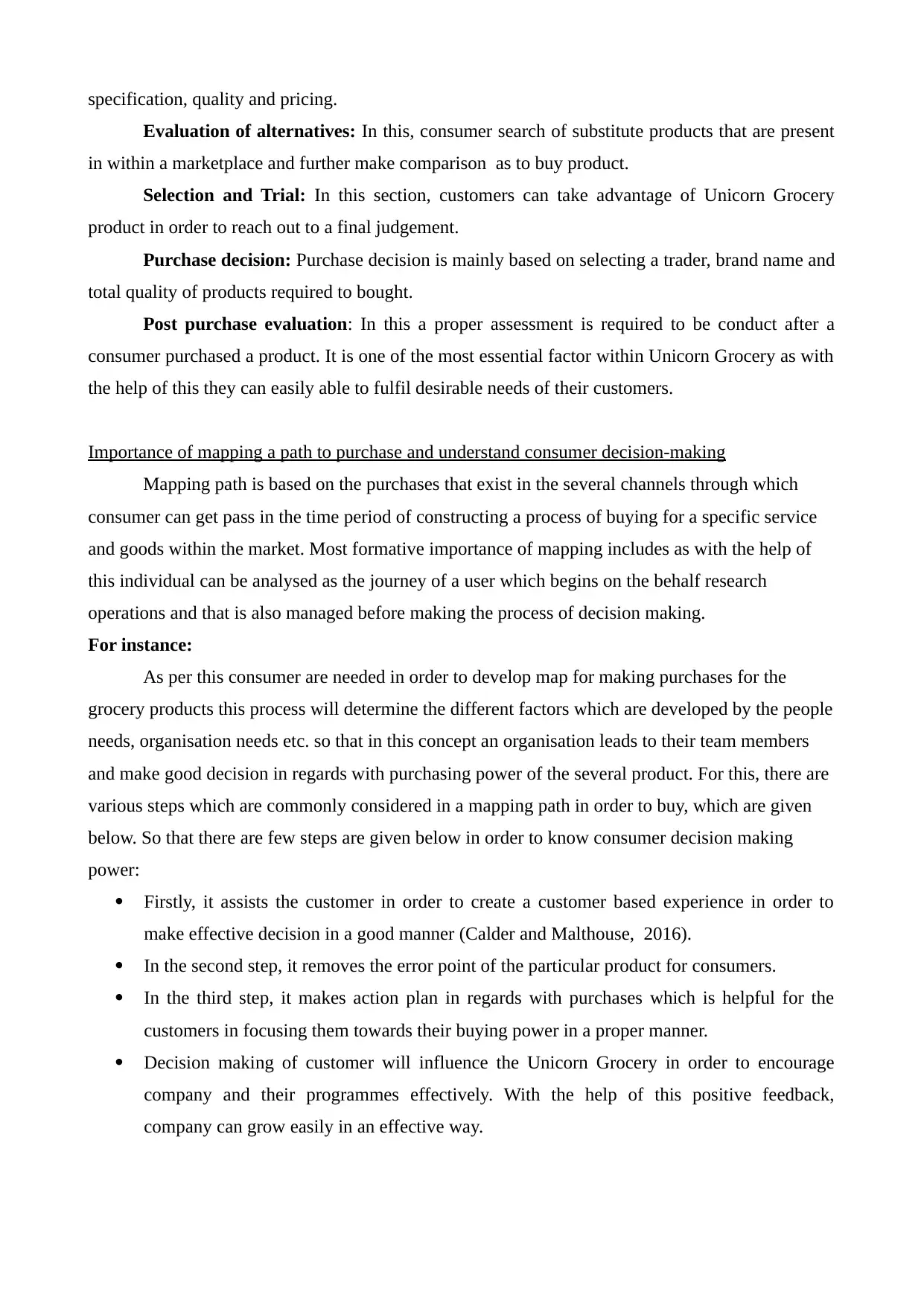
specification, quality and pricing.
Evaluation of alternatives: In this, consumer search of substitute products that are present
in within a marketplace and further make comparison as to buy product.
Selection and Trial: In this section, customers can take advantage of Unicorn Grocery
product in order to reach out to a final judgement.
Purchase decision: Purchase decision is mainly based on selecting a trader, brand name and
total quality of products required to bought.
Post purchase evaluation: In this a proper assessment is required to be conduct after a
consumer purchased a product. It is one of the most essential factor within Unicorn Grocery as with
the help of this they can easily able to fulfil desirable needs of their customers.
Importance of mapping a path to purchase and understand consumer decision-making
Mapping path is based on the purchases that exist in the several channels through which
consumer can get pass in the time period of constructing a process of buying for a specific service
and goods within the market. Most formative importance of mapping includes as with the help of
this individual can be analysed as the journey of a user which begins on the behalf research
operations and that is also managed before making the process of decision making.
For instance:
As per this consumer are needed in order to develop map for making purchases for the
grocery products this process will determine the different factors which are developed by the people
needs, organisation needs etc. so that in this concept an organisation leads to their team members
and make good decision in regards with purchasing power of the several product. For this, there are
various steps which are commonly considered in a mapping path in order to buy, which are given
below. So that there are few steps are given below in order to know consumer decision making
power:
Firstly, it assists the customer in order to create a customer based experience in order to
make effective decision in a good manner (Calder and Malthouse, 2016).
In the second step, it removes the error point of the particular product for consumers.
In the third step, it makes action plan in regards with purchases which is helpful for the
customers in focusing them towards their buying power in a proper manner.
Decision making of customer will influence the Unicorn Grocery in order to encourage
company and their programmes effectively. With the help of this positive feedback,
company can grow easily in an effective way.
Evaluation of alternatives: In this, consumer search of substitute products that are present
in within a marketplace and further make comparison as to buy product.
Selection and Trial: In this section, customers can take advantage of Unicorn Grocery
product in order to reach out to a final judgement.
Purchase decision: Purchase decision is mainly based on selecting a trader, brand name and
total quality of products required to bought.
Post purchase evaluation: In this a proper assessment is required to be conduct after a
consumer purchased a product. It is one of the most essential factor within Unicorn Grocery as with
the help of this they can easily able to fulfil desirable needs of their customers.
Importance of mapping a path to purchase and understand consumer decision-making
Mapping path is based on the purchases that exist in the several channels through which
consumer can get pass in the time period of constructing a process of buying for a specific service
and goods within the market. Most formative importance of mapping includes as with the help of
this individual can be analysed as the journey of a user which begins on the behalf research
operations and that is also managed before making the process of decision making.
For instance:
As per this consumer are needed in order to develop map for making purchases for the
grocery products this process will determine the different factors which are developed by the people
needs, organisation needs etc. so that in this concept an organisation leads to their team members
and make good decision in regards with purchasing power of the several product. For this, there are
various steps which are commonly considered in a mapping path in order to buy, which are given
below. So that there are few steps are given below in order to know consumer decision making
power:
Firstly, it assists the customer in order to create a customer based experience in order to
make effective decision in a good manner (Calder and Malthouse, 2016).
In the second step, it removes the error point of the particular product for consumers.
In the third step, it makes action plan in regards with purchases which is helpful for the
customers in focusing them towards their buying power in a proper manner.
Decision making of customer will influence the Unicorn Grocery in order to encourage
company and their programmes effectively. With the help of this positive feedback,
company can grow easily in an effective way.
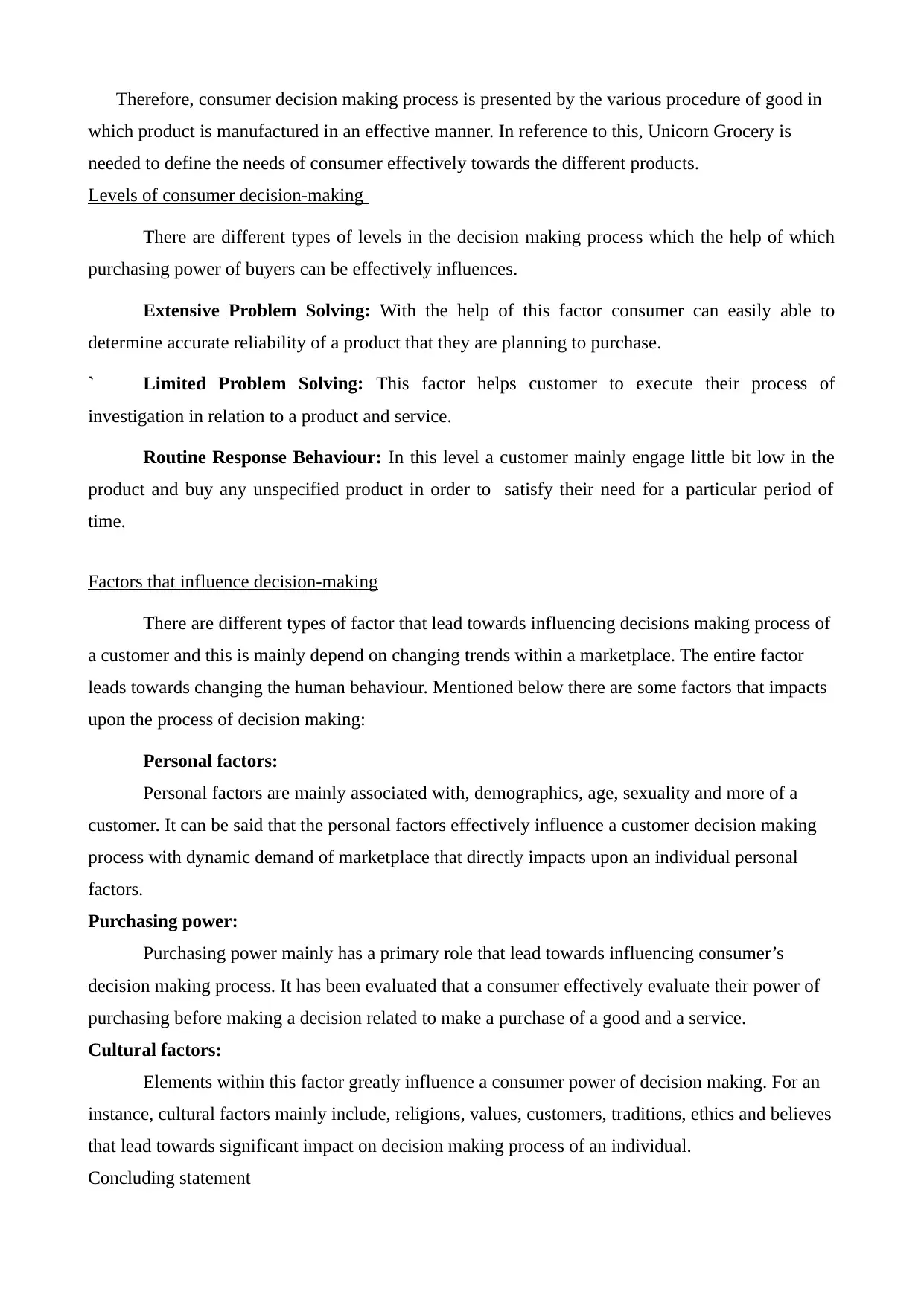
Therefore, consumer decision making process is presented by the various procedure of good in
which product is manufactured in an effective manner. In reference to this, Unicorn Grocery is
needed to define the needs of consumer effectively towards the different products.
Levels of consumer decision-making
There are different types of levels in the decision making process which the help of which
purchasing power of buyers can be effectively influences.
Extensive Problem Solving: With the help of this factor consumer can easily able to
determine accurate reliability of a product that they are planning to purchase.
` Limited Problem Solving: This factor helps customer to execute their process of
investigation in relation to a product and service.
Routine Response Behaviour: In this level a customer mainly engage little bit low in the
product and buy any unspecified product in order to satisfy their need for a particular period of
time.
Factors that influence decision-making
There are different types of factor that lead towards influencing decisions making process of
a customer and this is mainly depend on changing trends within a marketplace. The entire factor
leads towards changing the human behaviour. Mentioned below there are some factors that impacts
upon the process of decision making:
Personal factors:
Personal factors are mainly associated with, demographics, age, sexuality and more of a
customer. It can be said that the personal factors effectively influence a customer decision making
process with dynamic demand of marketplace that directly impacts upon an individual personal
factors.
Purchasing power:
Purchasing power mainly has a primary role that lead towards influencing consumer’s
decision making process. It has been evaluated that a consumer effectively evaluate their power of
purchasing before making a decision related to make a purchase of a good and a service.
Cultural factors:
Elements within this factor greatly influence a consumer power of decision making. For an
instance, cultural factors mainly include, religions, values, customers, traditions, ethics and believes
that lead towards significant impact on decision making process of an individual.
Concluding statement
which product is manufactured in an effective manner. In reference to this, Unicorn Grocery is
needed to define the needs of consumer effectively towards the different products.
Levels of consumer decision-making
There are different types of levels in the decision making process which the help of which
purchasing power of buyers can be effectively influences.
Extensive Problem Solving: With the help of this factor consumer can easily able to
determine accurate reliability of a product that they are planning to purchase.
` Limited Problem Solving: This factor helps customer to execute their process of
investigation in relation to a product and service.
Routine Response Behaviour: In this level a customer mainly engage little bit low in the
product and buy any unspecified product in order to satisfy their need for a particular period of
time.
Factors that influence decision-making
There are different types of factor that lead towards influencing decisions making process of
a customer and this is mainly depend on changing trends within a marketplace. The entire factor
leads towards changing the human behaviour. Mentioned below there are some factors that impacts
upon the process of decision making:
Personal factors:
Personal factors are mainly associated with, demographics, age, sexuality and more of a
customer. It can be said that the personal factors effectively influence a customer decision making
process with dynamic demand of marketplace that directly impacts upon an individual personal
factors.
Purchasing power:
Purchasing power mainly has a primary role that lead towards influencing consumer’s
decision making process. It has been evaluated that a consumer effectively evaluate their power of
purchasing before making a decision related to make a purchase of a good and a service.
Cultural factors:
Elements within this factor greatly influence a consumer power of decision making. For an
instance, cultural factors mainly include, religions, values, customers, traditions, ethics and believes
that lead towards significant impact on decision making process of an individual.
Concluding statement
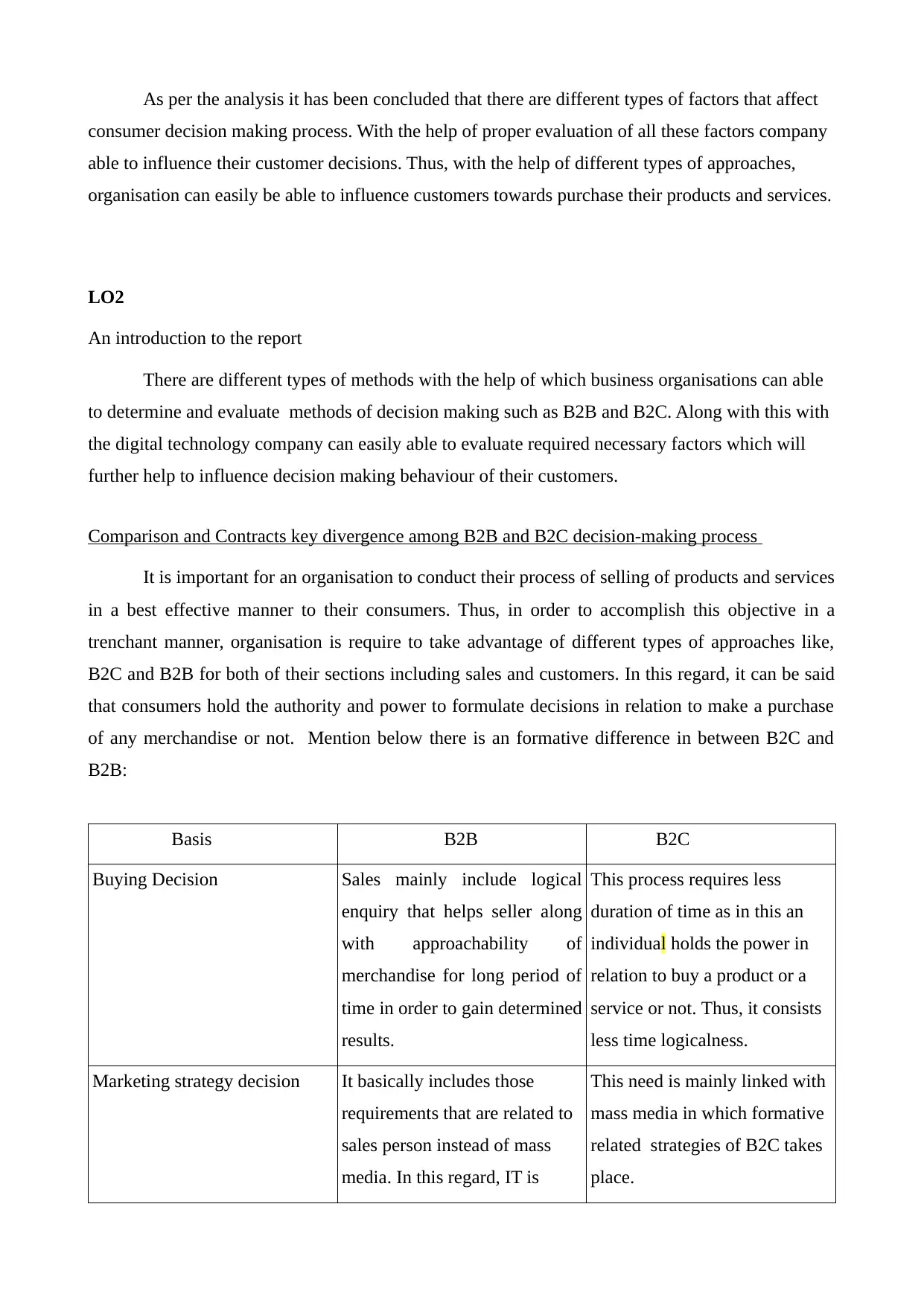
As per the analysis it has been concluded that there are different types of factors that affect
consumer decision making process. With the help of proper evaluation of all these factors company
able to influence their customer decisions. Thus, with the help of different types of approaches,
organisation can easily be able to influence customers towards purchase their products and services.
LO2
An introduction to the report
There are different types of methods with the help of which business organisations can able
to determine and evaluate methods of decision making such as B2B and B2C. Along with this with
the digital technology company can easily able to evaluate required necessary factors which will
further help to influence decision making behaviour of their customers.
Comparison and Contracts key divergence among B2B and B2C decision-making process
It is important for an organisation to conduct their process of selling of products and services
in a best effective manner to their consumers. Thus, in order to accomplish this objective in a
trenchant manner, organisation is require to take advantage of different types of approaches like,
B2C and B2B for both of their sections including sales and customers. In this regard, it can be said
that consumers hold the authority and power to formulate decisions in relation to make a purchase
of any merchandise or not. Mention below there is an formative difference in between B2C and
B2B:
Basis B2B B2C
Buying Decision Sales mainly include logical
enquiry that helps seller along
with approachability of
merchandise for long period of
time in order to gain determined
results.
This process requires less
duration of time as in this an
individual holds the power in
relation to buy a product or a
service or not. Thus, it consists
less time logicalness.
Marketing strategy decision It basically includes those
requirements that are related to
sales person instead of mass
media. In this regard, IT is
This need is mainly linked with
mass media in which formative
related strategies of B2C takes
place.
consumer decision making process. With the help of proper evaluation of all these factors company
able to influence their customer decisions. Thus, with the help of different types of approaches,
organisation can easily be able to influence customers towards purchase their products and services.
LO2
An introduction to the report
There are different types of methods with the help of which business organisations can able
to determine and evaluate methods of decision making such as B2B and B2C. Along with this with
the digital technology company can easily able to evaluate required necessary factors which will
further help to influence decision making behaviour of their customers.
Comparison and Contracts key divergence among B2B and B2C decision-making process
It is important for an organisation to conduct their process of selling of products and services
in a best effective manner to their consumers. Thus, in order to accomplish this objective in a
trenchant manner, organisation is require to take advantage of different types of approaches like,
B2C and B2B for both of their sections including sales and customers. In this regard, it can be said
that consumers hold the authority and power to formulate decisions in relation to make a purchase
of any merchandise or not. Mention below there is an formative difference in between B2C and
B2B:
Basis B2B B2C
Buying Decision Sales mainly include logical
enquiry that helps seller along
with approachability of
merchandise for long period of
time in order to gain determined
results.
This process requires less
duration of time as in this an
individual holds the power in
relation to buy a product or a
service or not. Thus, it consists
less time logicalness.
Marketing strategy decision It basically includes those
requirements that are related to
sales person instead of mass
media. In this regard, IT is
This need is mainly linked with
mass media in which formative
related strategies of B2C takes
place.
Paraphrase This Document
Need a fresh take? Get an instant paraphrase of this document with our AI Paraphraser
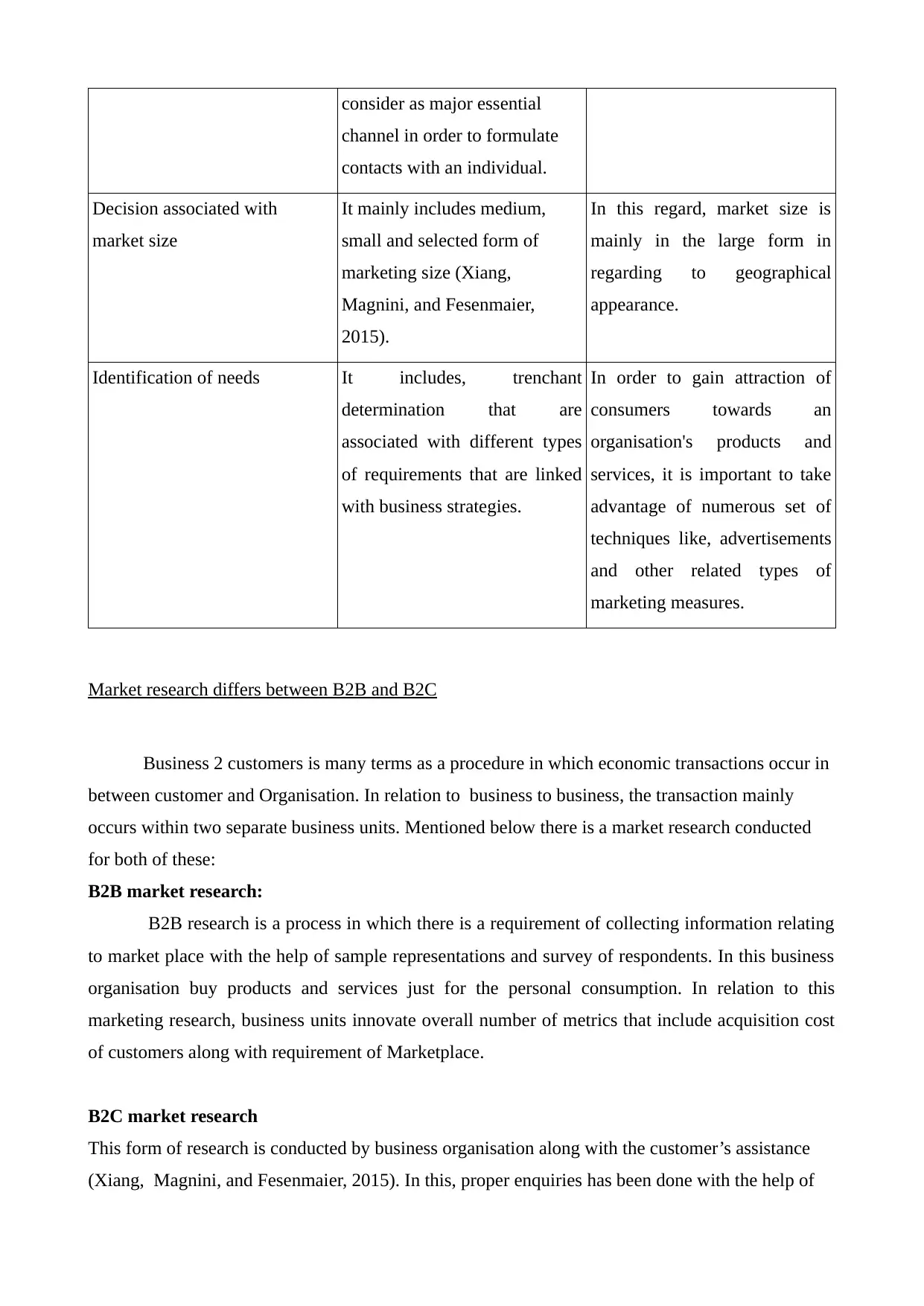
consider as major essential
channel in order to formulate
contacts with an individual.
Decision associated with
market size
It mainly includes medium,
small and selected form of
marketing size (Xiang,
Magnini, and Fesenmaier,
2015).
In this regard, market size is
mainly in the large form in
regarding to geographical
appearance.
Identification of needs It includes, trenchant
determination that are
associated with different types
of requirements that are linked
with business strategies.
In order to gain attraction of
consumers towards an
organisation's products and
services, it is important to take
advantage of numerous set of
techniques like, advertisements
and other related types of
marketing measures.
Market research differs between B2B and B2C
Business 2 customers is many terms as a procedure in which economic transactions occur in
between customer and Organisation. In relation to business to business, the transaction mainly
occurs within two separate business units. Mentioned below there is a market research conducted
for both of these:
B2B market research:
B2B research is a process in which there is a requirement of collecting information relating
to market place with the help of sample representations and survey of respondents. In this business
organisation buy products and services just for the personal consumption. In relation to this
marketing research, business units innovate overall number of metrics that include acquisition cost
of customers along with requirement of Marketplace.
B2C market research
This form of research is conducted by business organisation along with the customer’s assistance
(Xiang, Magnini, and Fesenmaier, 2015). In this, proper enquiries has been done with the help of
channel in order to formulate
contacts with an individual.
Decision associated with
market size
It mainly includes medium,
small and selected form of
marketing size (Xiang,
Magnini, and Fesenmaier,
2015).
In this regard, market size is
mainly in the large form in
regarding to geographical
appearance.
Identification of needs It includes, trenchant
determination that are
associated with different types
of requirements that are linked
with business strategies.
In order to gain attraction of
consumers towards an
organisation's products and
services, it is important to take
advantage of numerous set of
techniques like, advertisements
and other related types of
marketing measures.
Market research differs between B2B and B2C
Business 2 customers is many terms as a procedure in which economic transactions occur in
between customer and Organisation. In relation to business to business, the transaction mainly
occurs within two separate business units. Mentioned below there is a market research conducted
for both of these:
B2B market research:
B2B research is a process in which there is a requirement of collecting information relating
to market place with the help of sample representations and survey of respondents. In this business
organisation buy products and services just for the personal consumption. In relation to this
marketing research, business units innovate overall number of metrics that include acquisition cost
of customers along with requirement of Marketplace.
B2C market research
This form of research is conducted by business organisation along with the customer’s assistance
(Xiang, Magnini, and Fesenmaier, 2015). In this, proper enquiries has been done with the help of
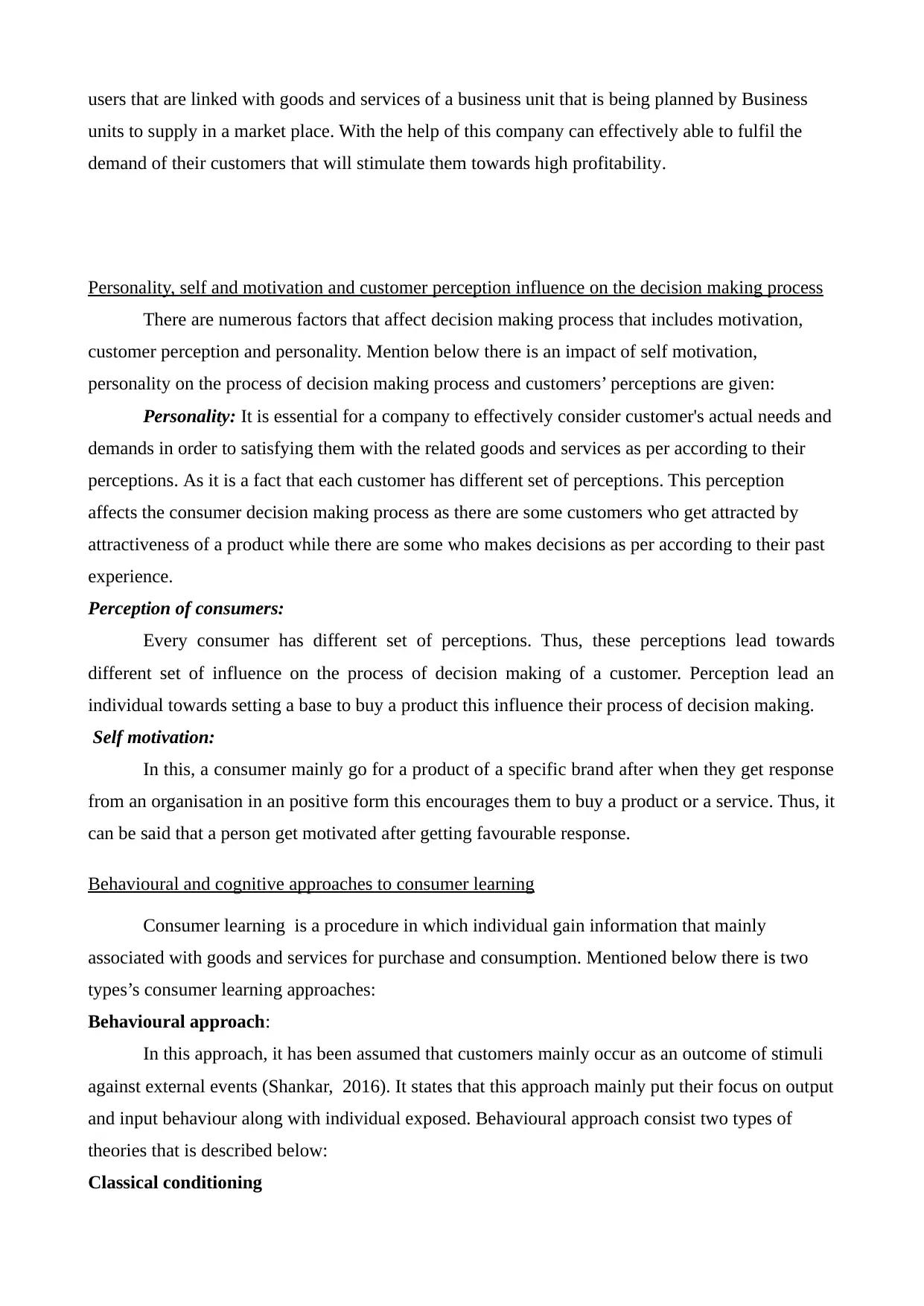
users that are linked with goods and services of a business unit that is being planned by Business
units to supply in a market place. With the help of this company can effectively able to fulfil the
demand of their customers that will stimulate them towards high profitability.
Personality, self and motivation and customer perception influence on the decision making process
There are numerous factors that affect decision making process that includes motivation,
customer perception and personality. Mention below there is an impact of self motivation,
personality on the process of decision making process and customers’ perceptions are given:
Personality: It is essential for a company to effectively consider customer's actual needs and
demands in order to satisfying them with the related goods and services as per according to their
perceptions. As it is a fact that each customer has different set of perceptions. This perception
affects the consumer decision making process as there are some customers who get attracted by
attractiveness of a product while there are some who makes decisions as per according to their past
experience.
Perception of consumers:
Every consumer has different set of perceptions. Thus, these perceptions lead towards
different set of influence on the process of decision making of a customer. Perception lead an
individual towards setting a base to buy a product this influence their process of decision making.
Self motivation:
In this, a consumer mainly go for a product of a specific brand after when they get response
from an organisation in an positive form this encourages them to buy a product or a service. Thus, it
can be said that a person get motivated after getting favourable response.
Behavioural and cognitive approaches to consumer learning
Consumer learning is a procedure in which individual gain information that mainly
associated with goods and services for purchase and consumption. Mentioned below there is two
types’s consumer learning approaches:
Behavioural approach:
In this approach, it has been assumed that customers mainly occur as an outcome of stimuli
against external events (Shankar, 2016). It states that this approach mainly put their focus on output
and input behaviour along with individual exposed. Behavioural approach consist two types of
theories that is described below:
Classical conditioning
units to supply in a market place. With the help of this company can effectively able to fulfil the
demand of their customers that will stimulate them towards high profitability.
Personality, self and motivation and customer perception influence on the decision making process
There are numerous factors that affect decision making process that includes motivation,
customer perception and personality. Mention below there is an impact of self motivation,
personality on the process of decision making process and customers’ perceptions are given:
Personality: It is essential for a company to effectively consider customer's actual needs and
demands in order to satisfying them with the related goods and services as per according to their
perceptions. As it is a fact that each customer has different set of perceptions. This perception
affects the consumer decision making process as there are some customers who get attracted by
attractiveness of a product while there are some who makes decisions as per according to their past
experience.
Perception of consumers:
Every consumer has different set of perceptions. Thus, these perceptions lead towards
different set of influence on the process of decision making of a customer. Perception lead an
individual towards setting a base to buy a product this influence their process of decision making.
Self motivation:
In this, a consumer mainly go for a product of a specific brand after when they get response
from an organisation in an positive form this encourages them to buy a product or a service. Thus, it
can be said that a person get motivated after getting favourable response.
Behavioural and cognitive approaches to consumer learning
Consumer learning is a procedure in which individual gain information that mainly
associated with goods and services for purchase and consumption. Mentioned below there is two
types’s consumer learning approaches:
Behavioural approach:
In this approach, it has been assumed that customers mainly occur as an outcome of stimuli
against external events (Shankar, 2016). It states that this approach mainly put their focus on output
and input behaviour along with individual exposed. Behavioural approach consist two types of
theories that is described below:
Classical conditioning
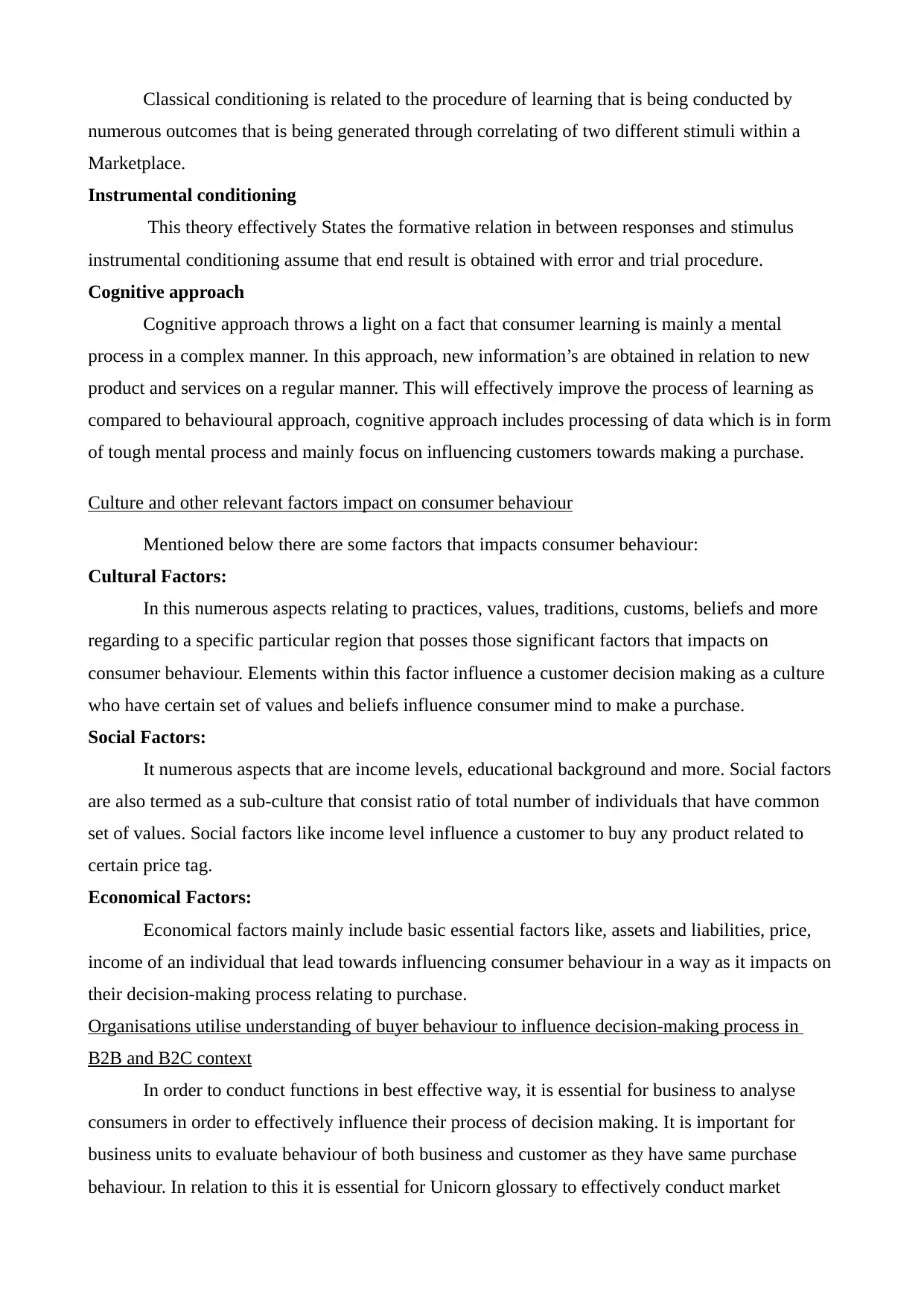
Classical conditioning is related to the procedure of learning that is being conducted by
numerous outcomes that is being generated through correlating of two different stimuli within a
Marketplace.
Instrumental conditioning
This theory effectively States the formative relation in between responses and stimulus
instrumental conditioning assume that end result is obtained with error and trial procedure.
Cognitive approach
Cognitive approach throws a light on a fact that consumer learning is mainly a mental
process in a complex manner. In this approach, new information’s are obtained in relation to new
product and services on a regular manner. This will effectively improve the process of learning as
compared to behavioural approach, cognitive approach includes processing of data which is in form
of tough mental process and mainly focus on influencing customers towards making a purchase.
Culture and other relevant factors impact on consumer behaviour
Mentioned below there are some factors that impacts consumer behaviour:
Cultural Factors:
In this numerous aspects relating to practices, values, traditions, customs, beliefs and more
regarding to a specific particular region that posses those significant factors that impacts on
consumer behaviour. Elements within this factor influence a customer decision making as a culture
who have certain set of values and beliefs influence consumer mind to make a purchase.
Social Factors:
It numerous aspects that are income levels, educational background and more. Social factors
are also termed as a sub-culture that consist ratio of total number of individuals that have common
set of values. Social factors like income level influence a customer to buy any product related to
certain price tag.
Economical Factors:
Economical factors mainly include basic essential factors like, assets and liabilities, price,
income of an individual that lead towards influencing consumer behaviour in a way as it impacts on
their decision-making process relating to purchase.
Organisations utilise understanding of buyer behaviour to influence decision-making process in
B2B and B2C context
In order to conduct functions in best effective way, it is essential for business to analyse
consumers in order to effectively influence their process of decision making. It is important for
business units to evaluate behaviour of both business and customer as they have same purchase
behaviour. In relation to this it is essential for Unicorn glossary to effectively conduct market
numerous outcomes that is being generated through correlating of two different stimuli within a
Marketplace.
Instrumental conditioning
This theory effectively States the formative relation in between responses and stimulus
instrumental conditioning assume that end result is obtained with error and trial procedure.
Cognitive approach
Cognitive approach throws a light on a fact that consumer learning is mainly a mental
process in a complex manner. In this approach, new information’s are obtained in relation to new
product and services on a regular manner. This will effectively improve the process of learning as
compared to behavioural approach, cognitive approach includes processing of data which is in form
of tough mental process and mainly focus on influencing customers towards making a purchase.
Culture and other relevant factors impact on consumer behaviour
Mentioned below there are some factors that impacts consumer behaviour:
Cultural Factors:
In this numerous aspects relating to practices, values, traditions, customs, beliefs and more
regarding to a specific particular region that posses those significant factors that impacts on
consumer behaviour. Elements within this factor influence a customer decision making as a culture
who have certain set of values and beliefs influence consumer mind to make a purchase.
Social Factors:
It numerous aspects that are income levels, educational background and more. Social factors
are also termed as a sub-culture that consist ratio of total number of individuals that have common
set of values. Social factors like income level influence a customer to buy any product related to
certain price tag.
Economical Factors:
Economical factors mainly include basic essential factors like, assets and liabilities, price,
income of an individual that lead towards influencing consumer behaviour in a way as it impacts on
their decision-making process relating to purchase.
Organisations utilise understanding of buyer behaviour to influence decision-making process in
B2B and B2C context
In order to conduct functions in best effective way, it is essential for business to analyse
consumers in order to effectively influence their process of decision making. It is important for
business units to evaluate behaviour of both business and customer as they have same purchase
behaviour. In relation to this it is essential for Unicorn glossary to effectively conduct market
Secure Best Marks with AI Grader
Need help grading? Try our AI Grader for instant feedback on your assignments.
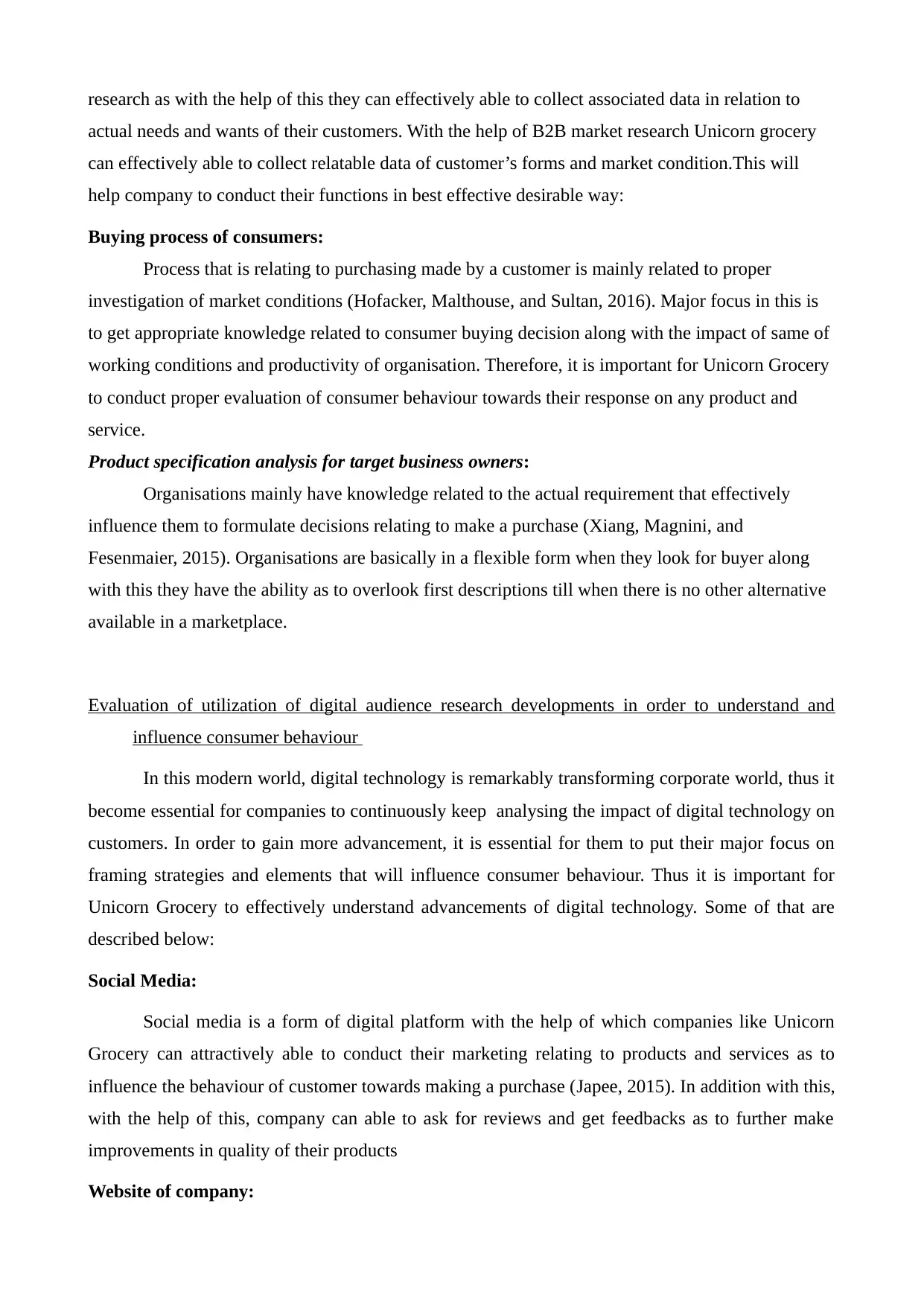
research as with the help of this they can effectively able to collect associated data in relation to
actual needs and wants of their customers. With the help of B2B market research Unicorn grocery
can effectively able to collect relatable data of customer’s forms and market condition.This will
help company to conduct their functions in best effective desirable way:
Buying process of consumers:
Process that is relating to purchasing made by a customer is mainly related to proper
investigation of market conditions (Hofacker, Malthouse, and Sultan, 2016). Major focus in this is
to get appropriate knowledge related to consumer buying decision along with the impact of same of
working conditions and productivity of organisation. Therefore, it is important for Unicorn Grocery
to conduct proper evaluation of consumer behaviour towards their response on any product and
service.
Product specification analysis for target business owners:
Organisations mainly have knowledge related to the actual requirement that effectively
influence them to formulate decisions relating to make a purchase (Xiang, Magnini, and
Fesenmaier, 2015). Organisations are basically in a flexible form when they look for buyer along
with this they have the ability as to overlook first descriptions till when there is no other alternative
available in a marketplace.
Evaluation of utilization of digital audience research developments in order to understand and
influence consumer behaviour
In this modern world, digital technology is remarkably transforming corporate world, thus it
become essential for companies to continuously keep analysing the impact of digital technology on
customers. In order to gain more advancement, it is essential for them to put their major focus on
framing strategies and elements that will influence consumer behaviour. Thus it is important for
Unicorn Grocery to effectively understand advancements of digital technology. Some of that are
described below:
Social Media:
Social media is a form of digital platform with the help of which companies like Unicorn
Grocery can attractively able to conduct their marketing relating to products and services as to
influence the behaviour of customer towards making a purchase (Japee, 2015). In addition with this,
with the help of this, company can able to ask for reviews and get feedbacks as to further make
improvements in quality of their products
Website of company:
actual needs and wants of their customers. With the help of B2B market research Unicorn grocery
can effectively able to collect relatable data of customer’s forms and market condition.This will
help company to conduct their functions in best effective desirable way:
Buying process of consumers:
Process that is relating to purchasing made by a customer is mainly related to proper
investigation of market conditions (Hofacker, Malthouse, and Sultan, 2016). Major focus in this is
to get appropriate knowledge related to consumer buying decision along with the impact of same of
working conditions and productivity of organisation. Therefore, it is important for Unicorn Grocery
to conduct proper evaluation of consumer behaviour towards their response on any product and
service.
Product specification analysis for target business owners:
Organisations mainly have knowledge related to the actual requirement that effectively
influence them to formulate decisions relating to make a purchase (Xiang, Magnini, and
Fesenmaier, 2015). Organisations are basically in a flexible form when they look for buyer along
with this they have the ability as to overlook first descriptions till when there is no other alternative
available in a marketplace.
Evaluation of utilization of digital audience research developments in order to understand and
influence consumer behaviour
In this modern world, digital technology is remarkably transforming corporate world, thus it
become essential for companies to continuously keep analysing the impact of digital technology on
customers. In order to gain more advancement, it is essential for them to put their major focus on
framing strategies and elements that will influence consumer behaviour. Thus it is important for
Unicorn Grocery to effectively understand advancements of digital technology. Some of that are
described below:
Social Media:
Social media is a form of digital platform with the help of which companies like Unicorn
Grocery can attractively able to conduct their marketing relating to products and services as to
influence the behaviour of customer towards making a purchase (Japee, 2015). In addition with this,
with the help of this, company can able to ask for reviews and get feedbacks as to further make
improvements in quality of their products
Website of company:
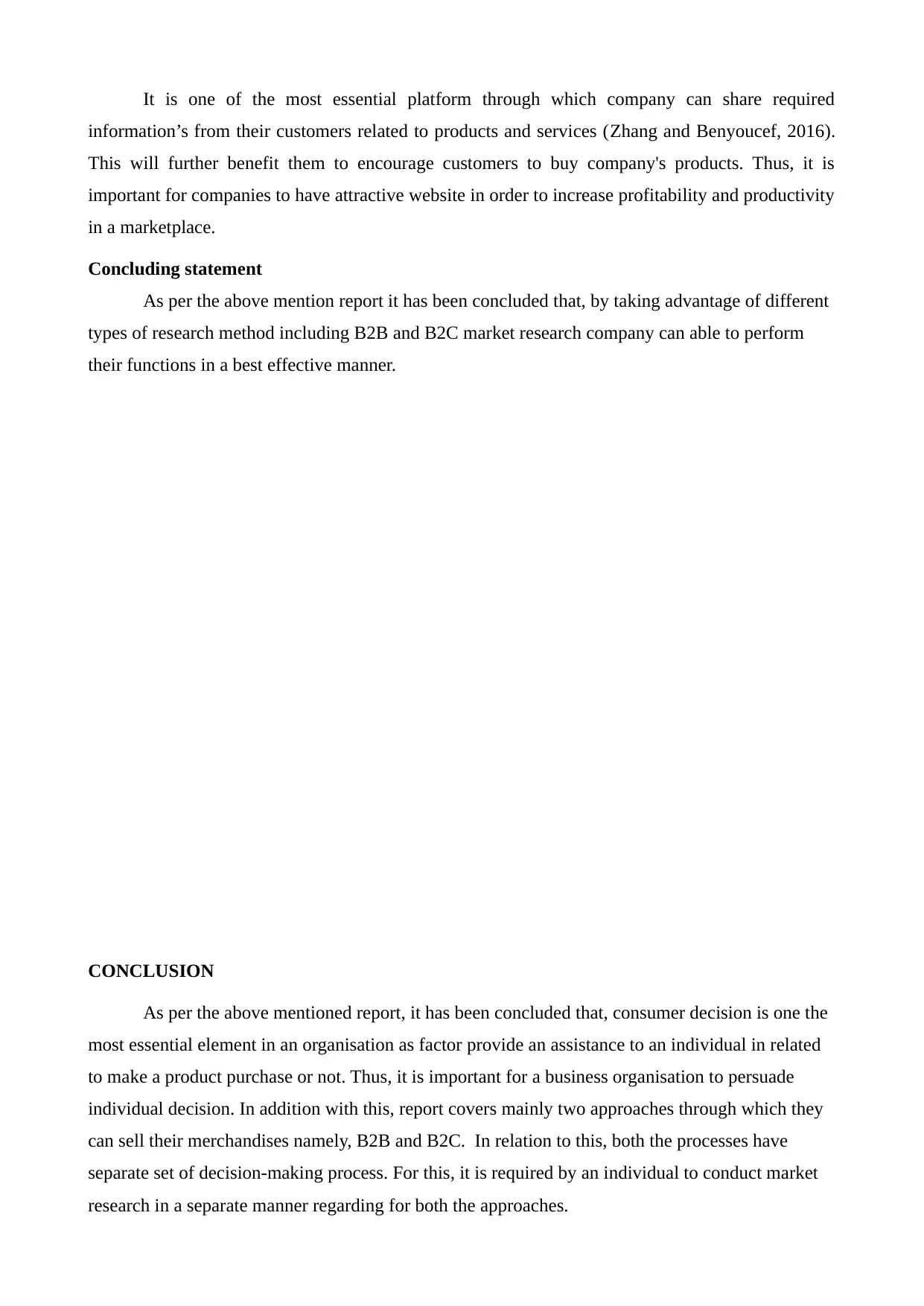
It is one of the most essential platform through which company can share required
information’s from their customers related to products and services (Zhang and Benyoucef, 2016).
This will further benefit them to encourage customers to buy company's products. Thus, it is
important for companies to have attractive website in order to increase profitability and productivity
in a marketplace.
Concluding statement
As per the above mention report it has been concluded that, by taking advantage of different
types of research method including B2B and B2C market research company can able to perform
their functions in a best effective manner.
CONCLUSION
As per the above mentioned report, it has been concluded that, consumer decision is one the
most essential element in an organisation as factor provide an assistance to an individual in related
to make a product purchase or not. Thus, it is important for a business organisation to persuade
individual decision. In addition with this, report covers mainly two approaches through which they
can sell their merchandises namely, B2B and B2C. In relation to this, both the processes have
separate set of decision-making process. For this, it is required by an individual to conduct market
research in a separate manner regarding for both the approaches.
information’s from their customers related to products and services (Zhang and Benyoucef, 2016).
This will further benefit them to encourage customers to buy company's products. Thus, it is
important for companies to have attractive website in order to increase profitability and productivity
in a marketplace.
Concluding statement
As per the above mention report it has been concluded that, by taking advantage of different
types of research method including B2B and B2C market research company can able to perform
their functions in a best effective manner.
CONCLUSION
As per the above mentioned report, it has been concluded that, consumer decision is one the
most essential element in an organisation as factor provide an assistance to an individual in related
to make a product purchase or not. Thus, it is important for a business organisation to persuade
individual decision. In addition with this, report covers mainly two approaches through which they
can sell their merchandises namely, B2B and B2C. In relation to this, both the processes have
separate set of decision-making process. For this, it is required by an individual to conduct market
research in a separate manner regarding for both the approaches.

Paraphrase This Document
Need a fresh take? Get an instant paraphrase of this document with our AI Paraphraser
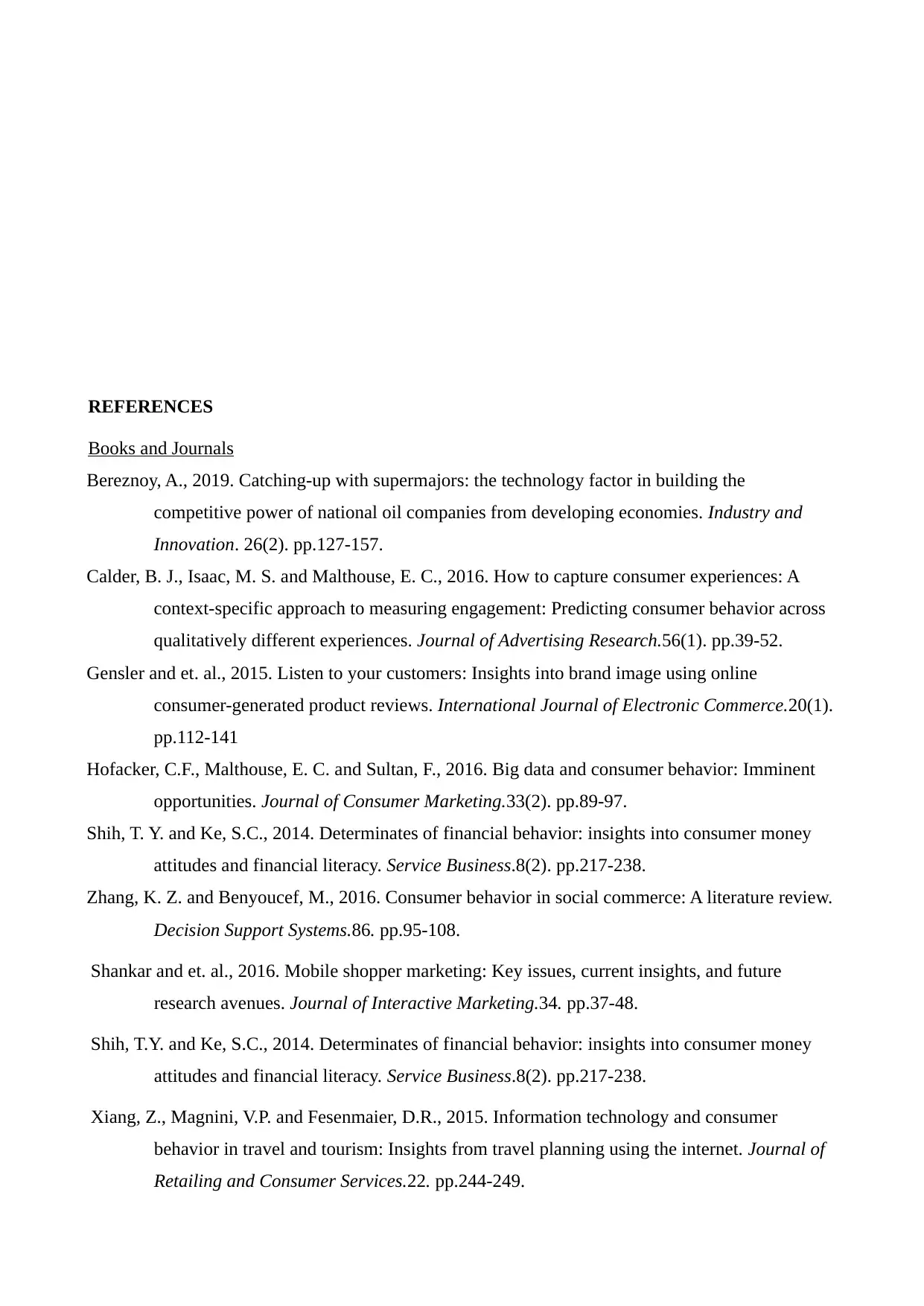
REFERENCES
Books and Journals
Bereznoy, A., 2019. Catching-up with supermajors: the technology factor in building the
competitive power of national oil companies from developing economies. Industry and
Innovation. 26(2). pp.127-157.
Calder, B. J., Isaac, M. S. and Malthouse, E. C., 2016. How to capture consumer experiences: A
context-specific approach to measuring engagement: Predicting consumer behavior across
qualitatively different experiences. Journal of Advertising Research.56(1). pp.39-52.
Gensler and et. al., 2015. Listen to your customers: Insights into brand image using online
consumer-generated product reviews. International Journal of Electronic Commerce.20(1).
pp.112-141
Hofacker, C.F., Malthouse, E. C. and Sultan, F., 2016. Big data and consumer behavior: Imminent
opportunities. Journal of Consumer Marketing.33(2). pp.89-97.
Shih, T. Y. and Ke, S.C., 2014. Determinates of financial behavior: insights into consumer money
attitudes and financial literacy. Service Business.8(2). pp.217-238.
Zhang, K. Z. and Benyoucef, M., 2016. Consumer behavior in social commerce: A literature review.
Decision Support Systems.86. pp.95-108.
Shankar and et. al., 2016. Mobile shopper marketing: Key issues, current insights, and future
research avenues. Journal of Interactive Marketing.34. pp.37-48.
Shih, T.Y. and Ke, S.C., 2014. Determinates of financial behavior: insights into consumer money
attitudes and financial literacy. Service Business.8(2). pp.217-238.
Xiang, Z., Magnini, V.P. and Fesenmaier, D.R., 2015. Information technology and consumer
behavior in travel and tourism: Insights from travel planning using the internet. Journal of
Retailing and Consumer Services.22. pp.244-249.
Books and Journals
Bereznoy, A., 2019. Catching-up with supermajors: the technology factor in building the
competitive power of national oil companies from developing economies. Industry and
Innovation. 26(2). pp.127-157.
Calder, B. J., Isaac, M. S. and Malthouse, E. C., 2016. How to capture consumer experiences: A
context-specific approach to measuring engagement: Predicting consumer behavior across
qualitatively different experiences. Journal of Advertising Research.56(1). pp.39-52.
Gensler and et. al., 2015. Listen to your customers: Insights into brand image using online
consumer-generated product reviews. International Journal of Electronic Commerce.20(1).
pp.112-141
Hofacker, C.F., Malthouse, E. C. and Sultan, F., 2016. Big data and consumer behavior: Imminent
opportunities. Journal of Consumer Marketing.33(2). pp.89-97.
Shih, T. Y. and Ke, S.C., 2014. Determinates of financial behavior: insights into consumer money
attitudes and financial literacy. Service Business.8(2). pp.217-238.
Zhang, K. Z. and Benyoucef, M., 2016. Consumer behavior in social commerce: A literature review.
Decision Support Systems.86. pp.95-108.
Shankar and et. al., 2016. Mobile shopper marketing: Key issues, current insights, and future
research avenues. Journal of Interactive Marketing.34. pp.37-48.
Shih, T.Y. and Ke, S.C., 2014. Determinates of financial behavior: insights into consumer money
attitudes and financial literacy. Service Business.8(2). pp.217-238.
Xiang, Z., Magnini, V.P. and Fesenmaier, D.R., 2015. Information technology and consumer
behavior in travel and tourism: Insights from travel planning using the internet. Journal of
Retailing and Consumer Services.22. pp.244-249.
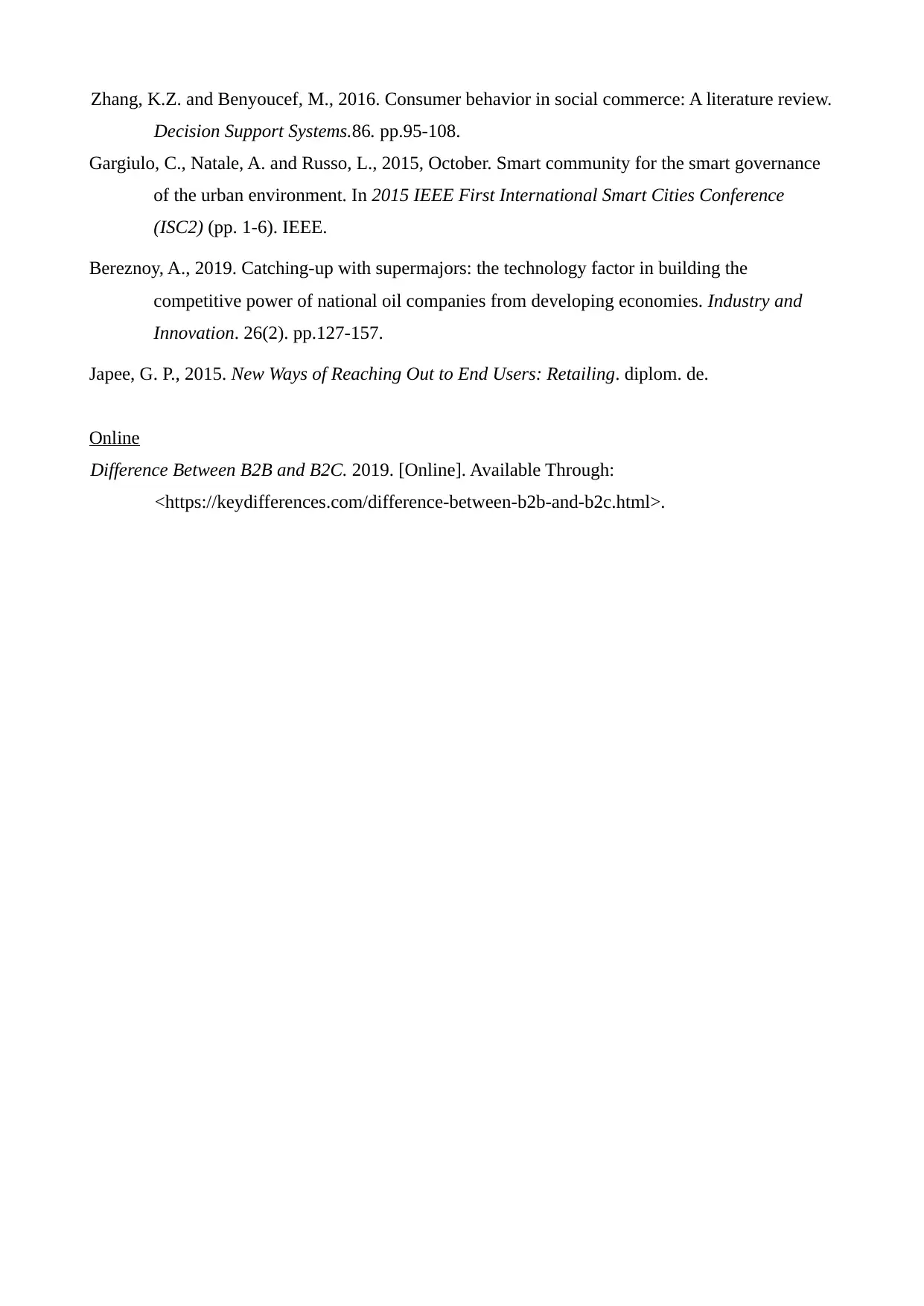
Zhang, K.Z. and Benyoucef, M., 2016. Consumer behavior in social commerce: A literature review.
Decision Support Systems.86. pp.95-108.
Gargiulo, C., Natale, A. and Russo, L., 2015, October. Smart community for the smart governance
of the urban environment. In 2015 IEEE First International Smart Cities Conference
(ISC2) (pp. 1-6). IEEE.
Bereznoy, A., 2019. Catching-up with supermajors: the technology factor in building the
competitive power of national oil companies from developing economies. Industry and
Innovation. 26(2). pp.127-157.
Japee, G. P., 2015. New Ways of Reaching Out to End Users: Retailing. diplom. de.
Online
Difference Between B2B and B2C. 2019. [Online]. Available Through:
<https://keydifferences.com/difference-between-b2b-and-b2c.html>.
Decision Support Systems.86. pp.95-108.
Gargiulo, C., Natale, A. and Russo, L., 2015, October. Smart community for the smart governance
of the urban environment. In 2015 IEEE First International Smart Cities Conference
(ISC2) (pp. 1-6). IEEE.
Bereznoy, A., 2019. Catching-up with supermajors: the technology factor in building the
competitive power of national oil companies from developing economies. Industry and
Innovation. 26(2). pp.127-157.
Japee, G. P., 2015. New Ways of Reaching Out to End Users: Retailing. diplom. de.
Online
Difference Between B2B and B2C. 2019. [Online]. Available Through:
<https://keydifferences.com/difference-between-b2b-and-b2c.html>.
1 out of 15
Related Documents
Your All-in-One AI-Powered Toolkit for Academic Success.
+13062052269
info@desklib.com
Available 24*7 on WhatsApp / Email
![[object Object]](/_next/static/media/star-bottom.7253800d.svg)
Unlock your academic potential
© 2024 | Zucol Services PVT LTD | All rights reserved.



![[SOLVED] Business Strategies for General Motors](/_next/image/?url=https%3A%2F%2Fdesklib.com%2Fmedia%2Fimages%2Fyh%2F9391c0ce33ae40759d76c3a8b774e192.jpg&w=256&q=75)

